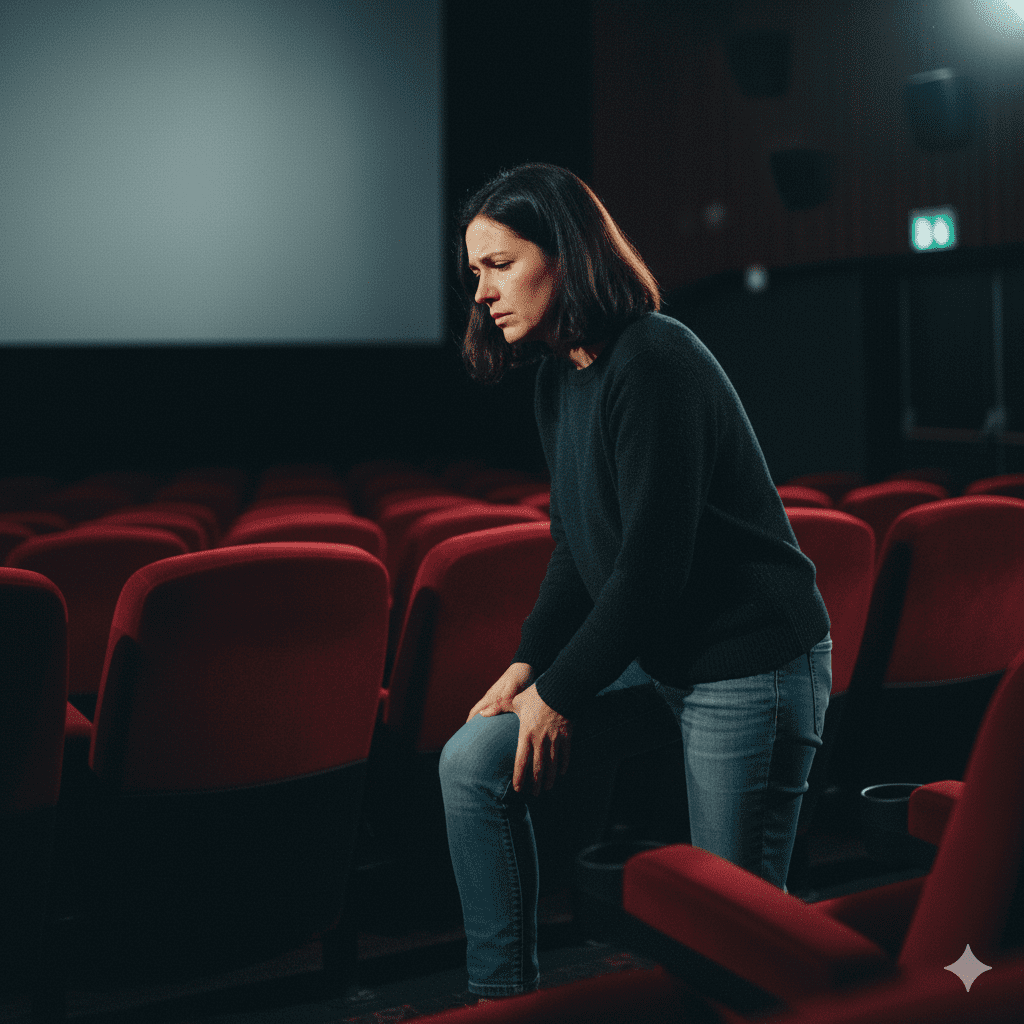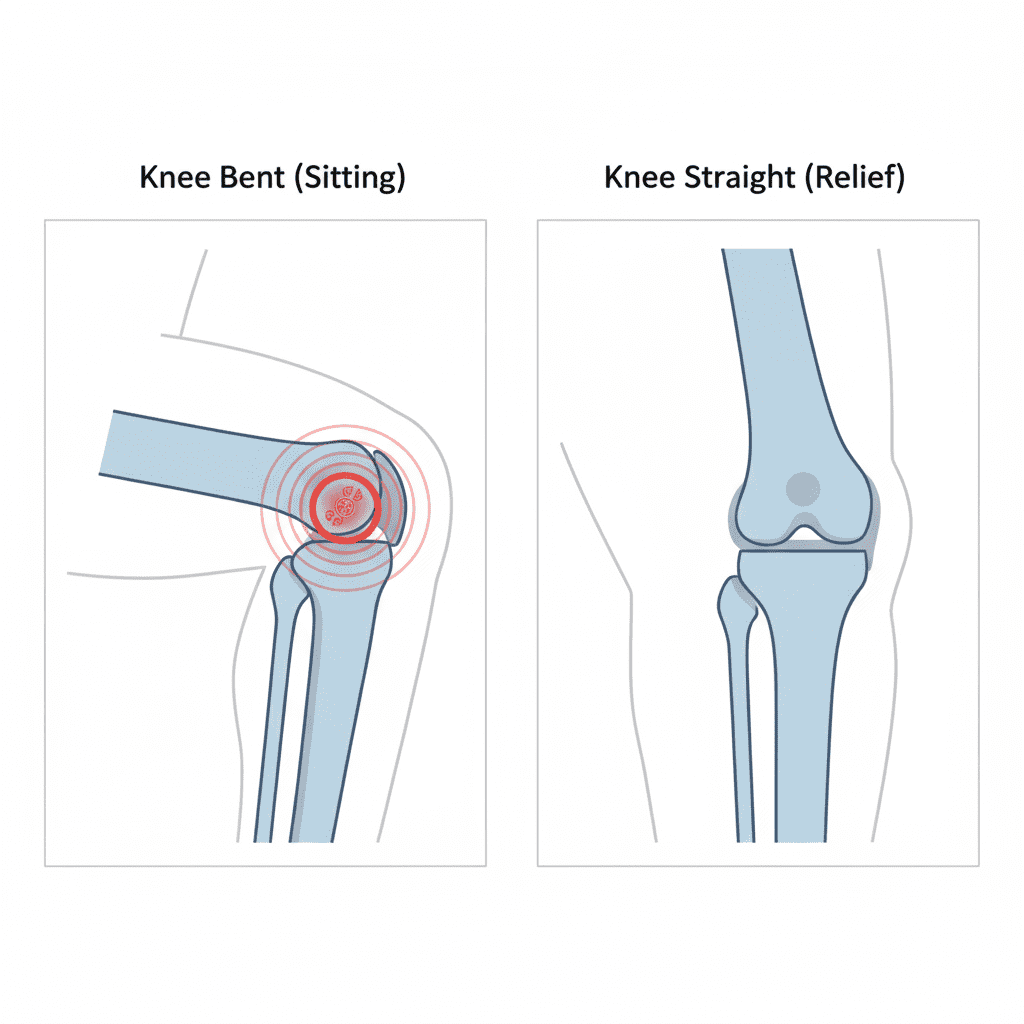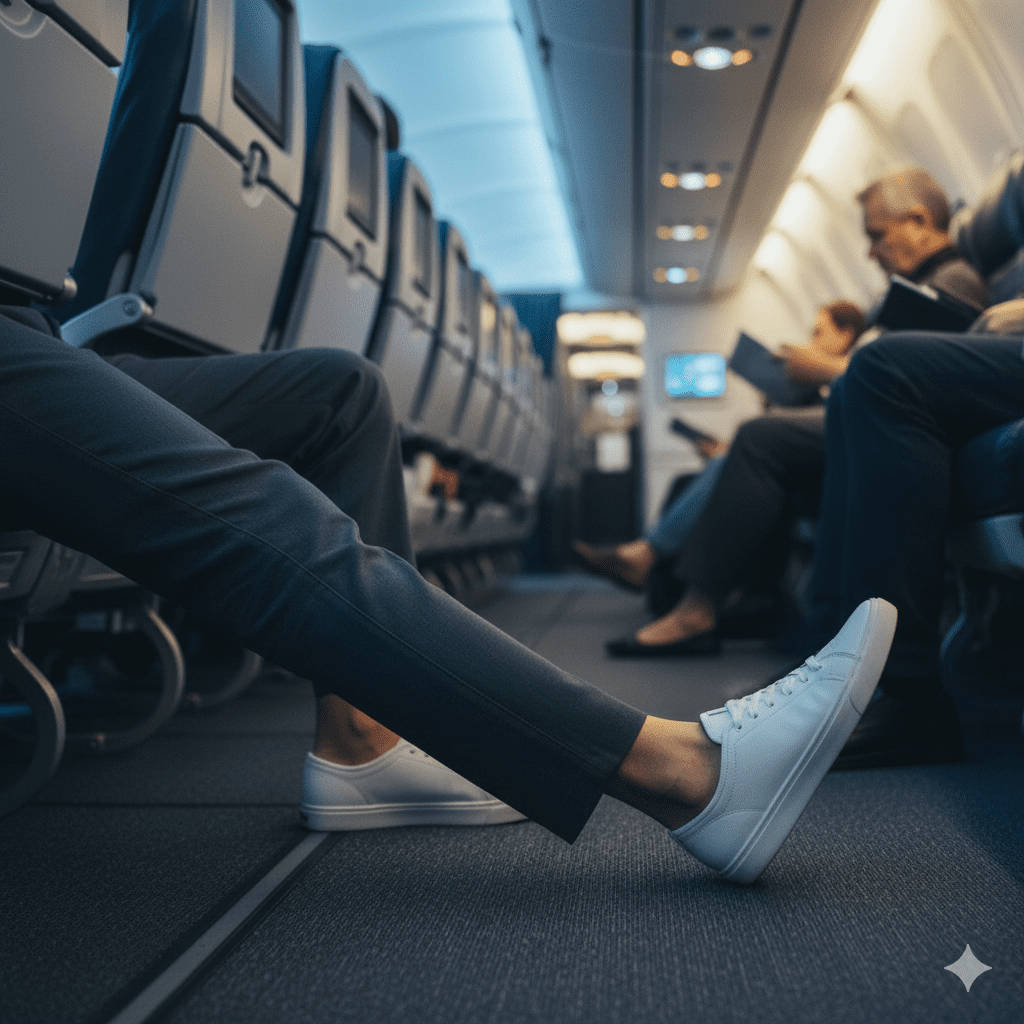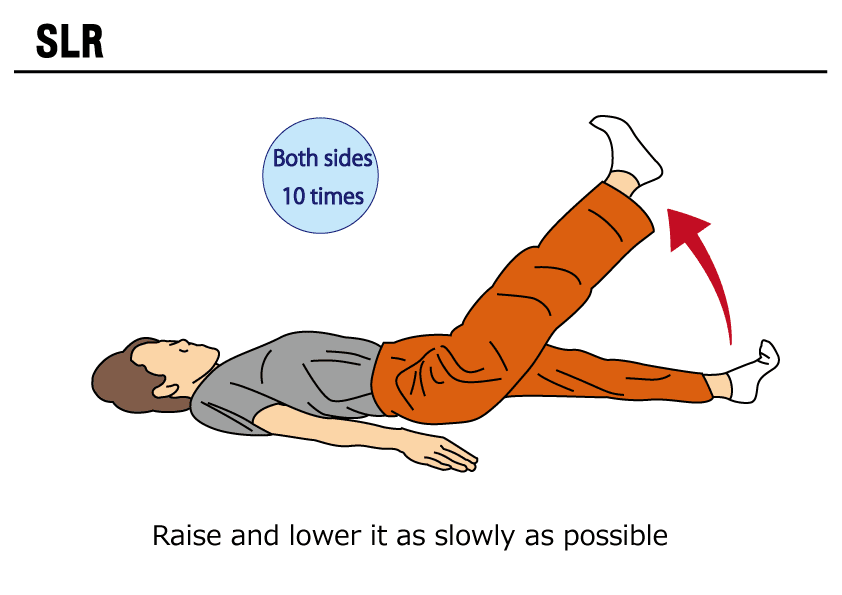
The movie was fantastic.
The credits are rolling, the triumphant score swells, and the house lights slowly come on.
You stretch, smile at your friend, and push yourself up to leave, and—OOF.
A stiff, grinding, achy protest from your knees.
It makes you walk like a rusty robot for the first 30 steps down the aisle.
Does that sound familiar?
If you’ve ever felt that specific ache, you might have what we affectionately call “Moviegoer’s Knee.”
It’s that predictable, frustrating knee pain after sitting for a long time with your knees bent.
While it’s not an official medical diagnosis, “Moviegoer’s Knee” perfectly describes the anterior knee pain from sitting that so many of us experience.
It happens during long car rides, on cramped flights, and yes, right in the middle of a movie marathon.
It can make you feel old, creaky, and annoyed. But here’s the good news: it’s incredibly common, and you have the power to manage it.
I vividly remember a time when I flew from Delhi to London. I was excited, but by hour six, my knees were screaming. When we landed, I could barely walk through the terminal without wincing. That was the turning point that led me to dive deep into understanding this specific type of pain…
This isn’t just a random ache. There’s real science behind that stiff knee when getting up, and understanding it is the first step to conquering it.
Let’s pull back the curtain on why your knees protest so loudly after the show.
The Science: Why Does My Knee ‘Lock Up’ in a Cinema Seat?

Your knee isn’t just a simple hinge. It’s a complex joint, and the star of this particular show is your kneecap, or patella.
Think of your patella as a shield that sits in a groove at the end of your thigh bone, the femur.
When you straighten and bend your leg, the patella glides smoothly up and down within this groove.
This entire mechanism is called the patellofemoral joint.
A Simple Case of Compression
When you sit for two hours with your knees bent at a 90-degree angle, you’re essentially pressing the back of your kneecap firmly against the thigh bone.
This constant, static pressure irritates the cartilage on the underside of the patella.
It’s the very definition of pain behind the kneecap when bent for a prolonged period.
Your body is designed for movement, not for being locked in one position.
The “Rusty Hinge” Analogy
Imagine the hinge on a garden gate that hasn’t been opened all winter. It’s stiff, creaky, and hard to move.
Your knee joint is similar.
It’s filled with a substance called synovial fluid, which acts like engine oil. It lubricates the joint, reduces friction, and nourishes the cartilage.
Movement is what circulates this fluid.
When you sit still, that circulation slows right down. The “oil” settles.
So, when you finally stand up, the joint is “dry.” The hinge is rusty.
That initial stiffness and ache is the joint complaining about the lack of lubrication and the irritation from being compressed.
After a few steps, movement gets the synovial fluid flowing again, the joint gets its oil back, and the pain usually subsides.
This is the classic story of movie theater knee pain.
The good news is that you don’t have to give up movies or dread long trips. You just need a better script.
We’ve broken down the solution into a simple 3-act play to help you manage and prevent this issue.
The 3-Act Solution to Moviegoer’s Knee
Think of your next outing as a performance. A little preparation and some mid-show adjustments can lead to a much happier ending for your knees.
Act I: The Pre-Show (Proactive Preparation)
What you do before you take your seat is just as important as what you do during the event.
Strategy 1: Wake Up Your Leg Muscles
Your muscles are the primary support system for your joints. If they’re “asleep” when you sit down, your knee joint takes on more stress.
Before you go into the theater or board the plane, activate your leg muscles.
- Take a Brisk Walk: Arrive 10 minutes early and walk around the lobby or terminal. This warms up the muscles and gets the synovial fluid moving.
- Do 10-15 Bodyweight Squats: Find a quiet corner or a bathroom stall. Go down as far as is comfortable. This fires up your quads, hamstrings, and glutes—the key protectors of the knee.
Waking up your muscles ensures they are ready to share the load, taking pressure off the patellofemoral joint itself.
Strategy 2: Choose Your Seat Wisely
This is one of the most effective and simplest tricks in the book.
An aisle seat is your best friend.
It gives you the freedom to stretch your leg out straight into the aisle periodically without bothering anyone.
This simple act of straightening the knee completely releases the pressure on your kneecap. It’s a game-changer for anyone wondering how to prevent knee pain on long flights or during a three-hour blockbuster.
Act II: The Main Feature (Mid-Movie Management)
You’re settled in, the lights are down, and the movie has started. Your job now is to be a subtle “seat fidgeter.” The goal is to avoid staying in one static position for too long.
Strategy 1: Perform “Seat Fidgets”

Every 20-30 minutes, perform these small, discreet movements.
- The Leg Straighten: If you have an aisle seat (or enough room), slowly straighten one leg out under the seat in front of you. Hold it for 30 seconds. Feel the release of pressure? Now switch legs.
- Ankle Pumps: This is the easiest one. Simply point your toes down toward the floor, then pull them up toward your shin. Repeat 15-20 times on each foot. This simple movement contracts your calf muscles, which helps pump blood and fluid back up your legs, reducing stiffness.
- Heel Slides: Gently slide your heel back towards the chair as far as it will go, then slide it forward again. This creates a small gliding motion in the knee joint, keeping that synovial fluid moving.
Strategy 2: Change Your Angle
Don’t just sit there like a statue.
Shift your weight from one side to the other.
Cross your ankles for a few minutes, then uncross them.
Tuck one foot under your seat while the other is extended.
Each tiny change in position alters the pressure points on your knee, preventing one specific area of cartilage from taking all the abuse.
Act III: The Post-Credits Scene (Immediate Relief)
The movie is over. This is the moment of truth. How you get up matters.
Strategy 1: The “Slow Rise”
Don’t just pop up out of your seat.
Place both feet firmly on the floor. Use the armrests to push yourself up slowly and deliberately.
Allow your body a moment to adjust to being upright.
This controlled movement prevents the sudden, jarring load that can cause that sharp, achy protest.
Strategy 2: A Gentle Wake-Up Call
Before you take your first step into the aisle, stand in place for a few seconds.
- Perform Gentle Leg Swings: Holding onto the chair for balance, gently swing one leg forward and backward 3-4 times. This is like a mini-pendulum, re-lubricating the joint before you ask it to bear your full weight.
- Do a Quick Hamstring Stretch: Place one heel on the seat of your chair (if it’s not too high) and gently lean forward until you feel a light stretch in the back of your thigh. Hold for 15 seconds. This helps release tension around the knee.
This two-step process ensures your “rusty hinge” gets a bit of oil before it has to swing wide open.
Building Long-Term Resilience: Chondromalacia Patella Exercises
While the 3-Act Solution is fantastic for in-the-moment relief, building stronger supporting muscles is the best way to prevent the problem long-term.
The term chondromalacia patella is a more formal diagnosis for when the cartilage under the kneecap becomes soft or damaged, often leading to this type of pain.
Strengthening the muscles that control the kneecap is key. Here are two simple exercises you can do at home:

- Quad Sets (Static Quads):
- Sit on the floor with your affected leg straight out in front of you.
- Place a small, rolled-up towel under your knee.
- Tighten the top muscle of your thigh (your quadriceps) and try to press the back of your knee down into the towel.
- You should see your kneecap pull slightly upwards.
- Hold for 5 seconds, then relax. Repeat 10-15 times.
- Straight Leg Raises:
- Lie on your back with your unaffected leg bent and foot flat on the floor.
- Keep your affected leg straight.
- Tighten your thigh muscle (quadriceps) on the straight leg, then slowly lift it about 6-8 inches off the floor.
- Keep the leg perfectly straight and the movement slow and controlled.
- Hold for 3-5 seconds, then slowly lower it back down.
- Aim for 10-12 repetitions.
These exercises help improve how your patella tracks in its groove, building a foundation of strength that protects you from knee pain after sitting.
Is It Just ‘Moviegoer’s Knee’ or Something More?
For most people, this situational stiffness is a harmless, albeit annoying, issue that can be managed.
However, it’s important to listen to your body. Your pain might be a sign of a more significant issue if you experience any of the following:
- Sharp, stabbing pain instead of a dull ache.
- Visible swelling around the knee after sitting or activity.
- A sensation of clicking, catching, or locking that doesn’t go away.
- Pain that persists during normal walking and doesn’t fade after a few minutes.
- Pain that keeps you awake at night.
If any of these sound familiar, it’s a good idea to get a professional opinion. A physiotherapist can properly diagnose the root cause and create a plan to address it.
You’re Ready for the Encore
That stiff knee when getting up doesn’t have to be your story’s ending.
“Moviegoer’s Knee” is very common, highly understandable, and most importantly, incredibly manageable with the right strategies.
You are no longer a passive victim of your cinema seat or your airplane cabin.
You now have the toolkit to prepare your knees for the show, manage them during the main feature, and help them recover gracefully during the credits.
You can enjoy a long movie, a cross-country flight, or an epic road trip without dreading those first few steps.
So go ahead, book that ticket. Your knees will thank you for it.
If your knee pain is starting to affect more than just your movie nights, it’s time for a proper diagnosis. A personalized strengthening and mobility program can address the root cause, not just the symptoms. Book your assessment with a Physiogain expert today at physiogain.com.